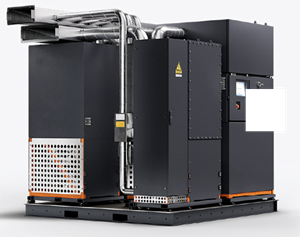Articles
Maximize methanol efficiency via fuel cell technology: The synergy between H2 and methanol
Special Focus: Fuel Cell Applications
A. BODEN, PowerCell Group, Gothenburg, Sweden
The maritime industry is undergoing a significant transformation as it aims to reach net-zero emissions, and renewable fuels are key in helping with this transition. As part of the shift toward more sustainable shipping practices, a wide range of alternative fuels are being explored, with eFuels emerging as one of the most promising options.
According to a survey conducted by Hydrogen Europe, eFuels are expected to play a crucial role in meeting the emissions reduction targets across various ship types, such as ferries, cruise ships and container vessels.1 Within this landscape, methanol reformer technology has gained attention as a key innovation. This technology enables the conversion of methanol into hydrogen (H2) through a process known as steam reforming, which allows a proton exchange membrane (PEM) fuel cell to use methanol with a 30% higher efficiency than conventional internal combustion engines (ICEs). Such an advancement creates new possibilities for compact, high-power solutions that can help achieve net-zero energy production without relying on either green methanol at an unrealistic scale or on a fully established H2 value chain (FIG. 1).
H2 is frequently referred to as the foundation of the energy transition, and it shows considerable promise for certain types of vessels, especially those with fixed or short routes such as passenger ferries or service vessels. However, PEM fuel cell’s adoption in long-distance, deep-sea shipping still faces considerable hurdles. These challenges are related to today’s limited availability of green H2 molecules, energy density concerns and the complex issues of H2 storage, transport and handling. While not a definitive solution, methanol offers a more practical alternative in the near term, helping to mitigate some of these challenges and support the transition to cleaner fuels.
Methanol: A convenient H2 carrier for the maritime industry. One of the key advantages of methanol is its ability to act as an efficient H2 carrier molecule. Unlike H2, methanol can be handled, stored and transported easily at ambient temperature and pressure. By acting as a carrier for H2, methanol eliminates many of the logistical difficulties that affect the broader adoption of H2 as a fuel, while still allowing for the use of high-efficiency fuel cells that generate power from H2. This synergy between methanol and fuel cell technology is expected to play a pivotal role in scaling renewable fuels for maritime applications.
When using green methanol, efficiency is vital because scaling up the production of green methanol to meet shipping’s needs in the near term is unlikely. From a more pessimistic perspective, marine economist Dr. Martin Stopford warned that the shipping industry could fall behind sectors like road transport and chemicals in securing access to renewable fuels.2 On a more positive note, the Methanol Institute has been tracking nearly 90 green methanol projects that are collectively aiming to produce as much as 9 MMtpy of renewable (green) methanol by 2027. If these projects bear fruit, they will provide a significant boost to the maritime sector by offering access to more sustainable fuel options.
Renewable methanol: A limited yet costly resource. Despite the growing optimism surrounding renewable methanol, its availability and affordability present significant barriers for the foreseeable future. According to Lloyd’s Register, the initial cost of renewable methanol is expected to be around $1,000/t, a substantial premium compared to conventional marine fuels.3 Given the higher cost, shipowners will be under pressure to maximize the efficiency of renewable methanol consumption to reduce operating expenditures (OPEX) and make the switch to these greener fuels more financially viable.
While methanol offers better energy density than H2 and ammonia, it still lags conventional hydrocarbon fuels in terms of energy output. Lloyd’s Register estimates that ship operators would need approximately 2.5 times more methanol than traditional fuel oil to achieve the same energy output.3 This disparity highlights the need for more efficient propulsion systems to make the most of limited renewable fuel resources.
A future of balance between sustainability and efficiency. The International Maritime Organization (IMO) has set ambitious targets to reduce greenhouse gas (GHG) emissions from international shipping, aiming for net-zero emissions by 2050, with key milestones set for 2030 and 2040. Achieving these targets will require innovative solutions that focus on the efficient use of renewable fuels, advanced propulsion systems and comprehensive decarbonization strategies.
The maritime industry is responsible for approximately 3% of global GHG emissions, making it an important sector in the fight against climate change. Fuel cells combined with methanol reformer technology offer a practical and effective means of addressing this challenge. Whether used to power smaller vessels or to support auxiliary systems on larger ships, these technologies provide a pathway to achieve net-zero emissions while also improving fuel efficiency and reducing OPEX.
The industry must embrace these innovative technologies to meet the IMO’s stringent emission targets. With fuel cells offering unparalleled efficiency and flexibility in fuel options, they represent one of the most promising solutions for shipowners looking to navigate the complex energy transition and contribute to a more sustainable future for the maritime sector.
Fuel cells as a solution to efficiency challenges. As previously alluded to, an efficient propulsion system in the form of fuel cells can utilize methanol reformer technology to convert methanol into H2 onboard. Through the process of steam reforming, fuel cells can generate power from methanol with a 30% higher efficiency than ICEs. PEM fuel cells are particularly well-suited for this task due to their compact size, high power density and superior efficiency.
For smaller vessels, such as passenger ferries and towboats, fuel cells can be used as the primary propulsion system, helping to reduce renewable methanol consumption by as much as 30%. In the case of larger vessels, such as container ships, fuel cells can be used to power auxiliary engines, significantly reducing emissions from fossil fuel-powered generators when operating in a port. This transition would not only reduce carbon emissions but also limit the production of harmful nitrogen oxide (NOx) emissions by up to 80%. Additionally, fuel cells powered by renewable methanol can eliminate sulfur oxide (SOx) and particulate matter (PM) emissions, contributing to cleaner air and healthier environments around busy ports.
The potential for fuel cells extends beyond methanol. Research is already underway to explore the use of ammonia as a fuel, with reformer technology being developed to efficiently convert ammonia into H2. This flexibility means that fuel cells can evolve alongside the broader energy transition, allowing shipowners to adopt renewable methanol as a starting point and transition to ammonia or other zero-carbon fuels as they become available.
As the maritime industry continues to explore renewable fuels and advanced propulsion technologies, methanol combined with fuel cell reformers presents a key opportunity to enhance energy efficiency, reduce emissions and achieve long-term sustainability. The synergy between H2 and methanol will be central to realizing a more sustainable and efficient future for global shipping. H2T
About the author

ANDREAS BODEN works at PowerCell Group as Senior Vice President and Chief Technology Officer and has more than 22 yr of experience in the research, development and commercialization of fuel cells. He has worked for PowercCell Group for 18 yr. Dr. Boden earned an MS degree and PhD in chemical engineering from KTH Royal Institute of Technology.
LITERAURE CITED
1 Hydrogen Europe, “Long-term outlook on zero-emission mobility,” February 2024, online: https://hydrogeneurope.eu/wp-content/uploads/2024/02/2024.02.14-Long-term-outlook-on-zero-emission-mobility_Report_14-02-2024_DIGITAL.pdf
2 Lloyd’s List, “Stopford: Shipping won’t get ‘a sniff’ of green fuel,” September 2023, online: https://www.lloydslist.com/LL1146577/Stopford-Shipping-wont-get-a-sniff-of-green-fuel
3 Lloyd’s Register, “Fuel for thought: Methanol report,” July 2023, online: https://www.lr.org/en/knowledge/research-reports/2023/fuel-for-thought-methanol-report/?


